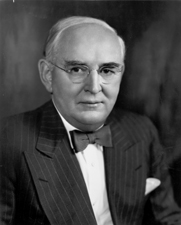^This is a guest post for the Acton PowerBlog.
By Gleaves Whitney
Some years ago, the bestselling biographer David McCullough outlined the “missing history” of our nation’s capital – the histories that had yet to be written. Among the people he believed merited more in-depth study was Michigan Sen. Arthur Vandenberg. In Hendrik Meijer’s latest biography, Arthur Vandenberg: The Man in the Middle of the American Century, McCullough’s wish comes true – and then some. No less a commentator than Cokie Roberts, lamenting the brokenness of American politics, counsels that “Every member of Congress should read [Meijer’s] book for a lesson in leadership.”
Published by the University of Chicago Press, Arthur Vandenberg is a significant achievement in American letters. First is its successful resurrection of a subject little-known outside of West Michigan. The Grand Rapidian’s career as a newspaper editor and biographer of Alexander Hamilton set the stage for “Van” to go to Washington in 1928 as a senator. In a career that spanned more than two decades, the politician grew into a statesman at a time when the Western world was desperate for bold leadership. Our civilization was in a fight for its life, first against a host of internal divisions that festered in the Great Depression, and then against an axis of dictators who attacked the heart of the civilization in a two-front world war. The age that gave us such outsized personalities as Churchill and Roosevelt and Patton also gave us the outsized Vandenberg.
Second is the book’s literary mastery. Even though the biography follows the genre’s conventional rhetorical strategy of unveiling its subject chronologically, Meijer makes a taut drama of Vandenberg’s personal struggles at home, his political battles in Washington, and his nation’s civilizational conflicts on the world stage. The author deftly avoids the extremes of hagiography and cynicism. There are things not to like about Vandenberg – his prickly, pompous personality, above all – and Meijer does not shrink from exposing the man, “warts and all,” including his adulterous attachment to the probable British agent and “luscious peach,” Mitzi Sims. Meijer sets up the possibility in an intriguing way: “While it is clear what attracted Vandenberg to Mitzi, one might wonder why the object of the senator’s passion responded as she did. Part of the answer may have been spy craft.” The narrative that follows (Chapter 11) reveals Meijer’s talent for combining the skills of a journalist with the sensibilities of a novelist – just the combination needed to pull off a first-rate biography. 
Third is the work’s lapidary wisdom for us today. There is no doubt that the Republican senator stood on principle. After all, he wrote multiple books about his hero, Alexander Hamilton, nearly a century before the Broadway musical swept Americans off their feet. Principles notwithstanding, Vandenberg again and again demonstrated practical wisdom. He understood that politics is the art of the possible; that half a loaf is better than no loaf at all; that principles must necessarily be in tension with expedience. Above all, he never forgot that the founders challenged every generation of Americans “to form a more perfect Union.” Thus, the senator showed the capacity to work with political opponents on both sides of the aisle. He could change his mind when the evidence warranted. He could bring isolationist Republicans around to his internationalist point of view when dissent was no longer a luxury the nation could afford (after Pearl Harbor). He could work with Democrats for the common good when the survival not just of the country but of the West was at stake (after the U.S.S.R. developed atomic weapons). His skill at crafting bipartisan legislation should be closely studied by students of statecraft. As Meijer observes, “Not to note his relevance today almost feels irresponsible.”
Americans today hunger for statesmanship. The justification for regarding Vandenberg as a statesman is that he did more than anticipate the next election cycle; he helped define U.S. foreign policy for decades to come. Meijer details how Vandenberg’s statesmanship was shaped – by his identification with Alexander Hamilton, his Midwestern roots, his newspaper work, his hard-charging personality that did not shrink from action. And while Vandenberg’s statesmanship may not have earned him the marble statues that Washington, Jefferson, and Lincoln enjoy, he is rightly celebrated for his marquee role in establishing many of the institutions that have given shape to our world – the FDIC, United Nations, NATO, and Marshall Plan, among them. It is also significant that, as a Republican, he steered the party’s foreign policy in a bipartisan direction that would help sustain American leadership through the Cold War and beyond. Vandenberg’s achievements are a monument to bipartisanship; not the “oh-well” of go-along-get-along squishes, but the determined cooperation of principled leaders who work tirelessly for lasting legislation that advances the common good.
When reading a biography critically, one looks at how an author approaches his subject, how he positions his text in context. What substantive contributions does the biography make? What evidence does the researcher find and use and interpret? Does the author treat the evidence honestly rather than ideologically? How about the rhetorical strategy he pursues to make his case? Is the resulting work a pleasure to read? Finally, is there an X-factor that surprises us, that reveals something significant we did not previously know?
By all of these criteria, Meijer’s book is a model of the genre, and the author can be counted among the finest biographers of our time. Few could be more devoted to the craft. Over the better part of a quarter century, Meijer undertook more exhaustive research about Vandenberg than any other human being ever has – by a long shot. He canvassed every relevant archive in the U.S., interviewed every source who knew Vandenberg personally, and collected a fascinating array of objects associated with the U.S. senator, enough to fill an estimable museum exhibit. He field-tested his ideas in a number of public presentations. It is no stretch to say that Meijer lived with Vandenberg in his imagination all those years: no one is in a better position to narrate and explicate the statesman’s words, actions, and beliefs.
Apropos of which, friends of the Acton Institute are no doubt curious to learn more of Vandenberg’s spiritual apprehensions in general and his denominational commitments in particular. If there is one criticism that attaches to Meijer’s book, it is that the biography is thin on Vandenberg’s inner life as it pertains to religion. But in fairness to Meijer, the available evidence on the topic is thin. It is unfortunate that Vandenberg did not write the memoir he had long planned, so biographers will be forever denied such insights. We should be grateful to Meijer for doing such an admirable job given the paucity of source material on the topic. Although formally a mainline Calvinist, Vandenberg was spiritually an exceedingly private man. He attended Park Congregational Church in Grand Rapids and New York Avenue Presbyterian Church in Washington, whose dynamic young minister, Peter Marshall, would also serve as chaplain of the U.S. Senate after World War II. Vandenberg met with Marshall frequently as the latter prepared daily invocations for the Senate. It is easy to imagine Vandenberg exploring the life of St. Paul with Marshall. “The Life of St. Paul” was the biography Vandenberg wanted to write but never got around to.
During many decades of immersion in the rough and tumble of politics, Vandenberg was too busy to devote much time to spiritual contemplation. Yet what spiritual questions he pursued were deepened as he lay dying of cancer in his Grand Rapids home. One of his daughters who attended him fretted over whether her father was spiritually at peace. To the Catholic convert Clare Booth Luce, he wrote, on his deathbed, “I have a little ‘prayer meeting’ all by myself each night.” From such moments Vandenberg learned that, as the end approaches, “every cloud has a silver lining, and the spiritual values in life come surging to the fore. They are so much more important than anything else.”
Gleaves Whitney is director of Grand Valley State University’s Hauenstein Center for Presidential Studies.
Photo: Michigan Senator Arthur Vandenberg welcomes new Congressman Gerald R. Ford Jr., to Washington DC. 1949. Gerald R. Ford Presidential Library

